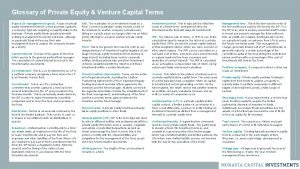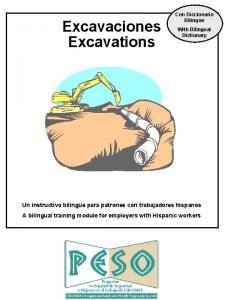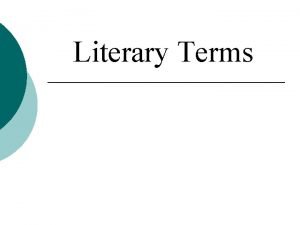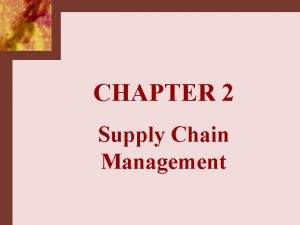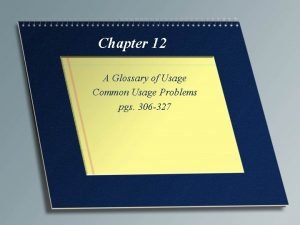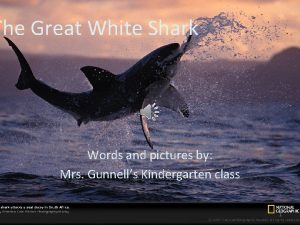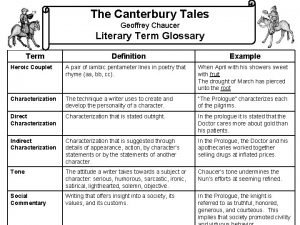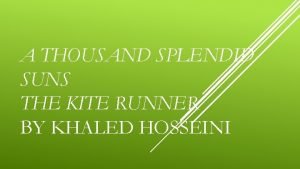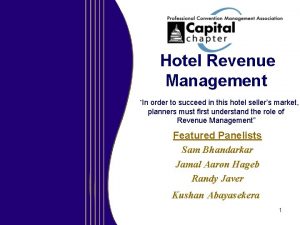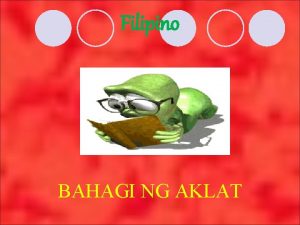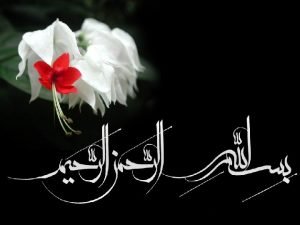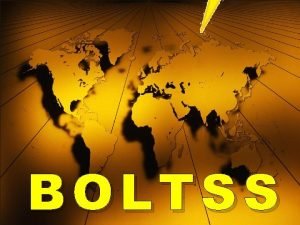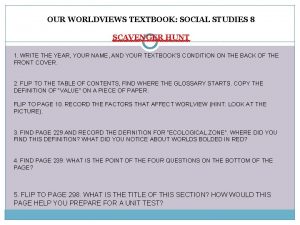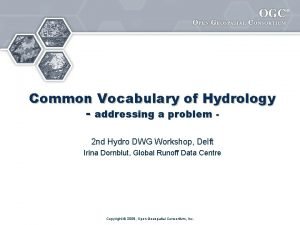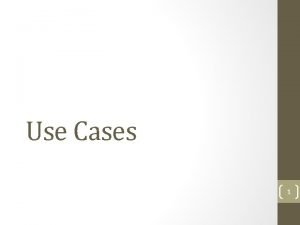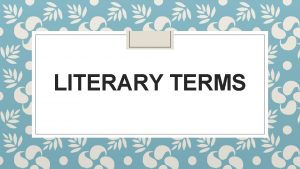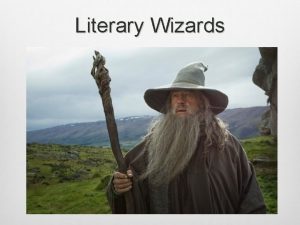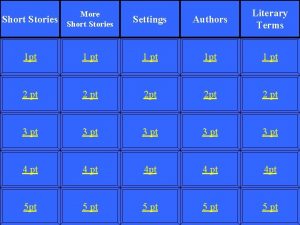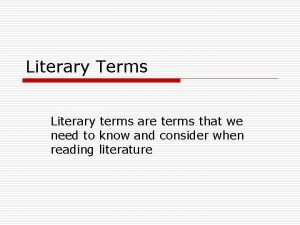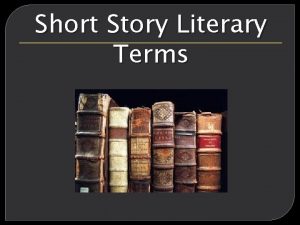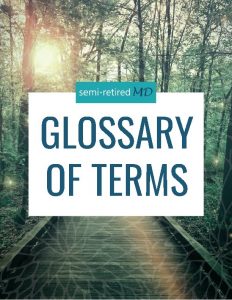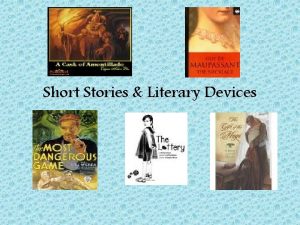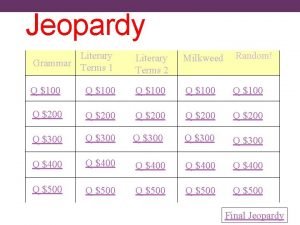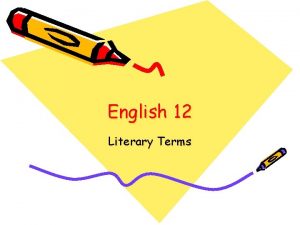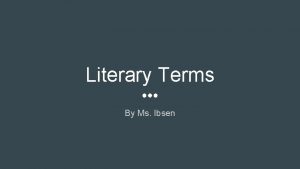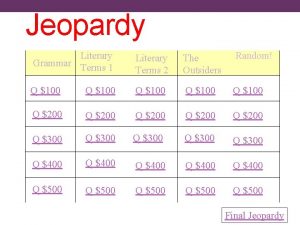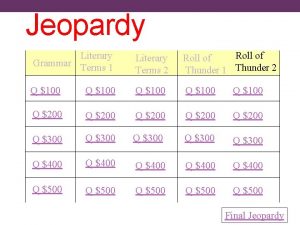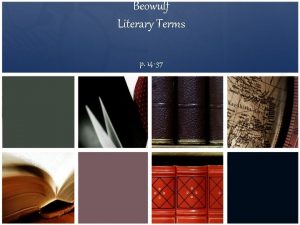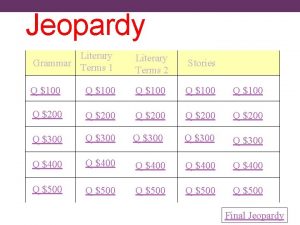Short Stories A short glossary of literary terms


















- Slides: 18

Short Stories A short glossary of literary terms

The Short Story The short story is a short work of fiction that is short enough to be read in one sitting but long enough to develop a plot and characters. n There are six basic elements that go into creating a short story: theme, plot, conflict, setting, symbolism, and characterization.

Theme is an observation of life which serves as the controlling idea in a literary work. n A theme is seldom presented word-for-word but is more often found as an abstract idea, surfacing through the actions and dialogues of characters, the use of symbols and recurring images, or the manipulation of other literary devices. n A theme should be expressed in a phrase, not merely one word. A topic is one word. A theme is what the author has to say about that topic.

Plot is the progression of events in a literary work. n Each part of the plot is so essential that if one part were removed, the whole structure would be disturbed. n Plot basically consists of the following: ¨ ¨ ¨ Exposition (setting and characters introduced) Initial incident (conflict begins) Rising Action (problem worsens) Climax (point where a decision must be made by hero/heroine) Falling Action (the consequences of the decision) Resolution & Denouement (problem is resolved and loose ends are tied up)

Plot Diagram: Climax Rising Action Exposition Falling Action Resolution

Frame Story Beginning/Opening Story within the opening story Story within the inner story

Conflict results from the struggle of two opposing forces. n One of the forces is usually a person who confronts one or more of five basic kinds of opposition: ¨ Man v. Self ¨ Man v. Man ¨ Man v. Society ¨ Man v. Nature ¨ Man v. Fate (Higher powers, i. e. gods, etc. )

Setting is the time and place of a narrative. n The physical aspects of setting include time of day or other particulars of the environment, such as location, topography, and the placement of objects. n The intangibles of setting include lifestyle and the predominant spiritual or moral atmosphere.

Symbolism is an economic method for exploring the unknown through the known. A familiar object is used to represent the unfamiliar. n The substitution demands that the reader transfer the relevant characteristics of the known to the unknown. n Example: Color symbolism – White usually symbolizes what? n Example: Animal symbolism – What does a dove usually represent?

Characterization is the creation of believable fictitious personalities. The basic methods of characterization include: n 1. an explicit statement by the author n 2. the character’s appearance n 3. the character’s thoughts n 4. the character’s actions, including mannerisms n 5. what the character says n 6. what others say about the character n 7. the aspects of setting which reflect influence of the character n 8. reactions of and to the character

Protagonist v. Antagonist A protagonist is the central character of a novel, drama, short story, or narrative poem. n An antagonist is the adversary or rival of the protagonist. n

Round v. Flat Characters Dynamic (or round) characters undergo a change in personality or character due to a series of events. n Static (or flat) characters do not change much over the course of the novel n ¨ They are used mainly to emphasize an important trait or two.

Explanation of Irony Verbal Irony: Saying one thing but meaning another, usually the opposite (sarcasm) n Dramatic Irony: Occurs when the reader/audience knows something that the character(s) does/do not know n Situational Irony: Occurs when the opposite of what is expected happens. n

Point of View n The perspective from which a narrative is told. ¨ First person: uses first person pronouns ¨ Third person omniscient: author can enter the minds of many or all characters ¨ Third person limited: author limits his omniscience to the minds of one or two characters ¨ Third person objective: the author does not enter a single mind but instead records what can be seen and heard. ¨ Stream of consciousness: narrator has no filter on his thoughts.

Pun A pun is a play on words that are either identical or similar in sound, but have sharply diverse meanings. n Mercutio, after being stabbed, says, “Ask for me tomorrow and you shall find me a grave man. ” n John Deere advertises: “Nothing runs like a Deere. ” n

Imagery What is it? n It consists of the words or phrases a writer uses to represent persons, objects, actions, feelings, and ideas by appealing to one or all of the five senses: seeing, hearing, tasting, smelling, feeling. n Can you think of any examples? n

Imagery What is it? n It consists of the words or phrases a writer uses to represent persons, objects, actions, feelings, and ideas by appealing to one or all of the five senses: seeing, hearing, tasting, smelling, feeling. n Can you think of any examples? n

Tone n n What is tone? Tone is the writer’s or speaker’s attitude toward a subject character, or audience, and it is conveyed through the author’s choice of words (diction) and detail. Tone can be serious, humorous, sarcastic, indignant, objective, etc. What kinds of tone were there in OFK?
 Short short short long long long short short short
Short short short long long long short short short Private equity vs venture capital
Private equity vs venture capital Osha glossary of terms
Osha glossary of terms Short story in literary terms
Short story in literary terms Total cost concept in supply chain management
Total cost concept in supply chain management Glossary of usage
Glossary of usage Great white pic
Great white pic Chaucer glossary
Chaucer glossary A thousand splendid suns timeline
A thousand splendid suns timeline Hotel revenue management glossary
Hotel revenue management glossary Pahina ng aklat halimbawa
Pahina ng aklat halimbawa Expertir
Expertir Boltss legend
Boltss legend Our worldviews
Our worldviews Managed futures glossary
Managed futures glossary International glossary of hydrology
International glossary of hydrology Ap spanish literature and culture reading list
Ap spanish literature and culture reading list Use case glossary
Use case glossary Who health promotion glossary
Who health promotion glossary

